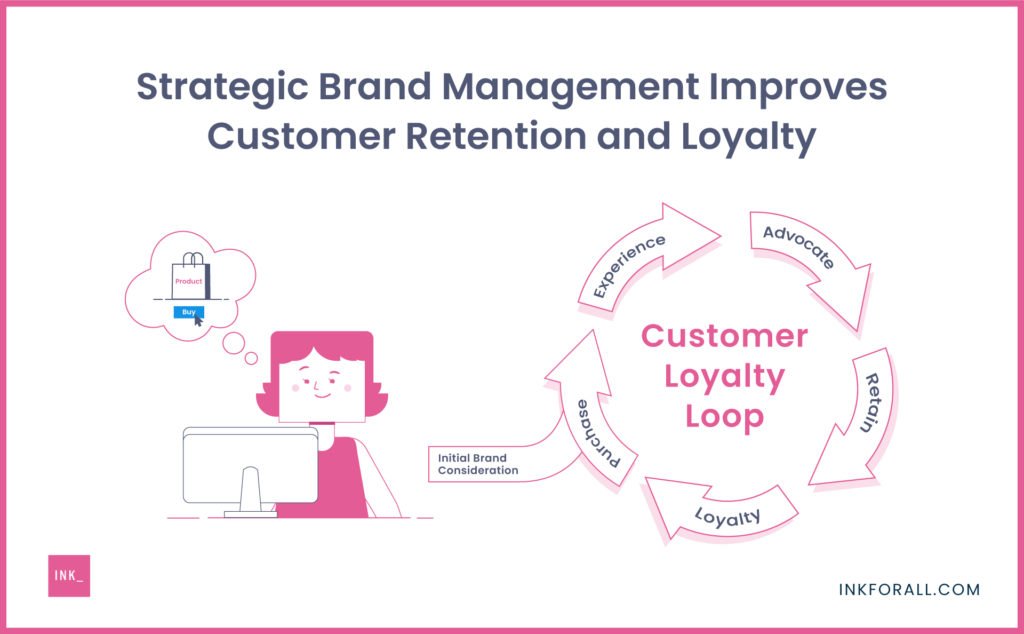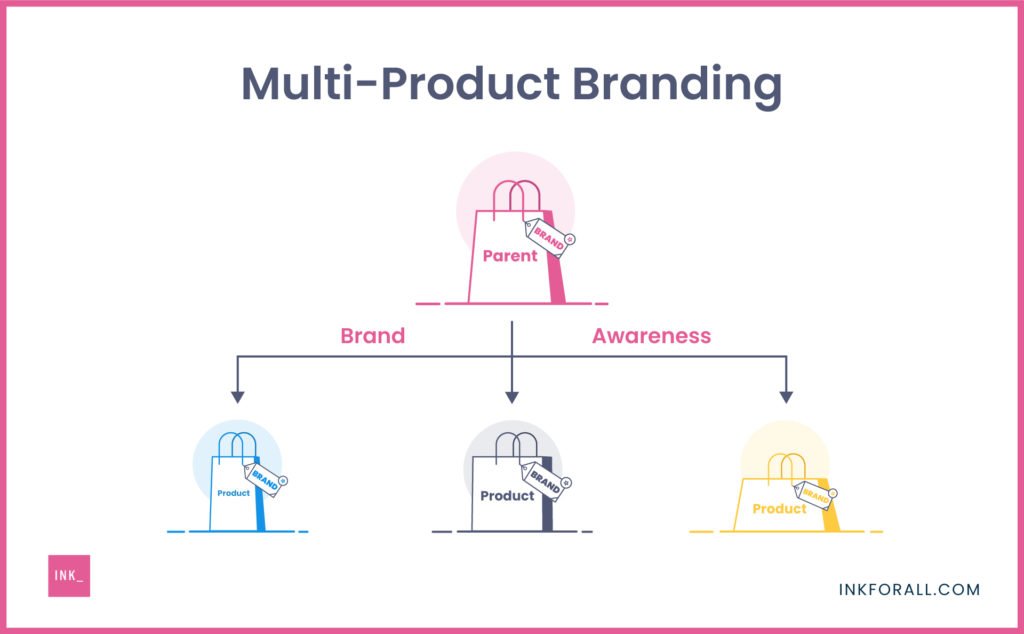Brand management is an approach that is centered around creating powerful, memorable brand awareness. But how exactly do you achieve this? Before we dig deeper into brand management, let us first understand the difference between a product and a brand.
Main Brand Management Takeaways:
- A product is a tangible or intangible good that a business sells to people.
- A brand is a concept built upon the perceptions, expectations, emotions, and experiences of people with the product.
- Brand management is a business management component that involves maintaining and improving products, services, and brand perception.
- Strategic brand management requires an action plan that you can execute to attain your company or business’s goals.
- Tone of voice pertains to how your brand speaks to or communicates with your prospective customers.
- If you want to add weight and distinctiveness to your brand, you need to establish your brand’s tone of voice and use it consistently.


What is the Difference Between a Product and a Brand?
People tend to confuse these two terms, using brand names to refer to products or vice versa. But, they are two different things. Let’s see how they differ from each other below.
Companies Create Products, and Customers Create Brands
The main distinction between the two is that companies create products, whereas consumers make the brands. A product is a tangible or intangible good that a business sells to people. Meanwhile, a brand is a concept built upon the perceptions, expectations, emotions, and experiences of people with the product.
Let’s take Nike as an example. Nike’s main product is shoes. One of its popular shoe lines is Nike Air.
You go to a Nike store, of course, to shop for shoes. But, when you think of its brand Nike Air, you don’t necessarily have to see or touch any product. In your mind, you can easily associate Nike Air with durability and lightweight footwear.
That’s what you call branding — the identity and reputation a brand built based on the experiences and perception of its previous customers.


Eviction Notice: Writer’s Block
Get unstuck with INK. Craft high-quality content effortlessly. Never be stopped by writer’s block again.
Products Can be Copied but not Brands
Your competitors can easily copy your product. For instance, when Apple launched its first iOS-powered smartphone (iPhone), it didn’t take long for its competitors to launch their versions of smartphones.
However, each brand associated with these smartphones offers unique value based on people’s perceptions and previous experiences with their brands.
Brands are Timeless but not Products
Yes, brands are here to stay. An excellent example is Elvis Presley. During his time, Elvis was an icon and a sought-after musician. He managed to turn himself into a household brand that people recognize to this day.
However, as opposed to brands, products can become obsolete, like vinyl and cassette tapes. People listen to Elvis until now, but not on vinyl or cassette tapes because these music players (products) are mostly obsolete.
With this understanding of the critical differences between what makes a product versus a brand, let’s move on to brand management.
What is Brand Management?


Brand management is a business management component that involves maintaining and improving products, services, and brand perception. It is an umbrella term that describes all the aspects of advertising, design, placement, and distribution to promote brand reputation and identity.
Brand management can significantly increase your brand’s perceived value over time. It can give you cost leverage, improve customer loyalty, and help your company establish meaningful brand awareness.
Think of your company or business as a seed that you planted. Its branches and leaves are your brand(s) that will flourish as you continue to grow and nurture your business.
As your tree grows, you need to prune it. This ensures that it will grow based on the configuration of the limbs and branches suitable for its structural integrity. It works pretty much the same with your business’s brand.
As you scale (grow) your business (tree), you also need to make adjustments (prune/trim) to your brand (leaves/branches) to ensure that it resonates with your company’s values and identity. But, to make these adjustments, you need to put in place an effective brand management strategy.
What is the Importance of Strategic Brand Management?
Strategic brand management requires an action plan that you can execute to attain your company or business’s goals. It is crucial to ensure that your brand’s aesthetic and intangible aspects are aligned. This means managing all the elements your business uses to portray a perfect image to your target customers.
Strategic brand management will not only help you create a successful image and brand reputation but also achieve the following:
- More significant brand differentiation and appeal
- Customer retention and loyalty
- Better perception of your product’s performance
- Effective marketing communication
- Accelerate customer response
Aspects of Strategic Brand Management


Strategic brand management encompasses these aspects:
- Identifying the proper planning process
- Establishing brand position
- Implementing a brand marketing program
- Measuring and interpreting brand performance
- Growing and sustaining brand equity
Identifying the Right Planning Process
By identifying the optimal planning process, you can ensure that departments across your company understood the values of your strategic plan and that they will adhere to it. The values you set must be aligned with your brand management strategy and centered on achieving your business’s mission and vision.
Establishing Brand Position
This aspect is crucial in convincing your target customers that your brand is better than your competitors. It involves analyzing your business’s position in the market. It also includes depicting your market associations and explaining the essence of your brand.
Implementing Brand Marketing Program
Involves selecting elements for brand promotion, including details like images, symbols, logos, and slogans, to name a few. This aspect also includes creating unique brand associations through different marketing programs and activities.
Measuring and Interpreting Brand Performance
Involves understanding your brand value chain by analyzing the impact of your brand marketing investments and expenses on your finances. Measuring your brand performance will also help in analyzing the source of your brand equity.
Growing and Sustaining Brand Equity
This aspect will help define your brand strategy through an effective brand equity management system. Brand portfolio tools and brand-product matrix are crucial here to ensure the success of your future marketing programs.
What are the Different Brand Management Strategies?
There are several brand management strategies that you can utilize to build and improve your brand reputation. However, choosing the right approach and understanding its impact on your business and brand identity is integral to making intelligent decisions. Here are the different brand management strategies:
Multi-Product Branding


This strategy involves using a business’s brand name for all its products within a class. This product and management branding approach is also commonly referred to as family branding or corporate branding. Multi-product branding allows companies to focus customer loyalty on the parent brand, not just the individual product brands.
Apple, Samsung, Sony, and many international brand names take great advantage of multi-product branding. For instance, Sony is a parent brand name. But, you’ll also see it plastered on many of its products, like the PlayStation series and Xperia smartphones.
Multi-product branding aims to pass over brand awareness from the parent brand to the product class. This allows for more efficient brand promotion.
However, using this approach can also lead to a weaker brand image. That’s because the more you use your parent brand name on products of different classes, the more diluted your brand equity gets.
To counter the negative effect of multi-product branding, companies utilize it together with the sub-branding approach.
Sub-branding
Sub-branding is a strategy where a company uses its parent brand name on its products. But, it will give each product a distinct brand name of its own. It helps marketers and businesses differentiate their products. It is also useful in managing the expectations of customers.
Sub-brands are almost always associated with the parent brand and appear in the context of the latter. Sub-branding’s primary goal is to provide a way for businesses to improve customer loyalty while expanding into new revenue streams.
Some examples of successful sub-branding are the following:
- Coca-Cola’s Coca-Cola No Sugar
- FedEx’s FedEx Express
- Virgin’s Virgin Atlantic
- Toyota’s Toyota Prius
- Samsung’s Samsung Galaxy
- AMD’s AMD Ryzen
- Lenovo’s Lenovo Legion
- Microsoft’s Microsoft Xbox
- Sony’s Sony PlayStation
- Apple’s Apple iPhone
- Amazon’s Amazon Echo
Individual Branding
Individual branding is a brand management strategy where a company creates a unique brand name for each product that it sells. So, it works by giving a product its own distinct identity. Then it will be introduced to the public under a unique brand name.
This brand management system is standard among large organizations to shield their parent brand’s reputation against individual product fails.
Other advantages of this approach include:
- Ability to use different marketing methods
- Capture a variety of customer demographics simultaneously
- Position individual brand to large consumer groups
Organizations like Procter & Gamble (P&G) and Unilever use this approach to build their products’ brand names and reputations. For instance, P&G has over 60 leading brands, including Gillette, Pampers, and Tide. Unilever, on the other hand, has over 400 brands in 190 countries. Some of the most popular ones are Lipton, Axe, Dove, TRESemmé, and Cif.
Of course, individual brand management has its downside. This brand management system has a higher risk of instability within the parent brand. Moreover, introducing a new brand name often entails an enormous cost.
Co-branding
Co-branding is an approach where a new brand is created and introduced into the market by combining two popular brands. However, the new brand’s characteristics are rooted in the core competencies and attributes of the two existing brands.
Co-branding is an effective way to break into new markets, boost awareness, and capture the prospective customers of each brand. But, if you’re not familiar with it, here are some examples of popular co-branding campaigns:
- GoPro and Red Bull’s Stratos
- Kanye West and Adidas’s Yeezy
- Apple and Mastercard’s Apple Pay
- Amazon and American Express’s Amazon Business American Express Card
- Nike and Apple’s Nike+
Bonus Tip: Finding Your Brand’s Voice
A critical aspect of strategic brand management is communication. You need to communicate to your target customers and introduce your brand.
One effective way of communicating with customers is through brand copywriting. But, if you want to come up with compelling copy, you need to find your brand’s tone of voice.
Tone of voice is how you want to speak or communicate with your prospective customers. It’s how you want your business or brand’s character to come through in your copy. It pertains to how you say things and what impression you want to create.
Read More: What Is Integrated Marketing Communications?
Here are some things to ponder as you formulate the tone you want to go for. What is your company’s vision? Do you want to be perceived as fun, hip and edgy? Then this should come through in copy that is dynamic and uses language that resonates with this type of audience.
Or, are you going for a more serious, authoritative brand voice? Then, write copy that is more direct and straightforward to reinforce this view of your brand.


Perhaps you are going for something in between, or a different company vision altogether. Whatever that is, take how you want your company to be perceived and infuse that attitude and vision into your copy.
Carrying that tone and using it across you brand messaging will be a key part of your brand strategy.
If you want to add distinctiveness to your brand, you need to find your brand’s tone of voice and use it consistently. Your copy should reflect your brand’s core messaging. It should also adhere to your brand management strategy.
When writing your brand copy, ask yourself the following questions:
- What is your brand messaging?
- Does your brand copywriting adhere to your brand management strategy?
- Are you following an editorial style guide?
- If scaled to different media, will your brand copywriting still work?
These questions will guide you as you write your copy and communicate with your audience. Brand copywriting is an underrated aspect of brand management. But, always keep in mind that the wrong choice of words and tone of voice could significantly impact how people perceive your brand.
Final Thoughts
Knowing these principles is just part of crafting a successful brand management approach. But, if you want to create a unique brand identity and boost your brand reputation, you need to implement the right brand management strategy. Moreover, you need groundbreaking ideas that are sustainable and consistent with your business’s mission and vision.
Lastly, communicating with your prospective customers is a crucial factor in the success of your brand management strategy. Find your tone of voice and write relevant and compelling brand copy. If you’re struggling with this part, INK has some fantastic tools that can help you. Check them out and try them for free here.
